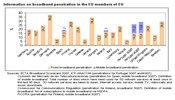As at the end of December, there were around 1.44 million users with mobile Internet access and around 1.73 million fixed Internet accesses, of which approximately 1.63 million were broadband.
Mobile broadband saw the highest rate of growth in 2007. The number of users increased by 256 thousand over the 4th quarter, representing a rise of almost 22 per cent compared to the third quarter. The values recorded in December 2007 represent an accumulated rate of growth of around 88% over January.
Along with the high rate of growth seen in the number of mobile broadband accesses, their use has also grown. The number of mobile broadband users who were active during the period being reported grew by around 38 per cent compared to the previous quarter, rising to 478 thousand users, a figure that is 137% higher than the value recorded in January.
If we consider the Internet access traffic of mobile accesses as an indicator of the intensity of use, growth is even higher, with the volume of traffic (in MB) up 43% over the previous quarter.
Meanwhile, the number of fixed Internet access service customers (around 1.68 million) grew by around 3.3 per cent in compared to the previous quarter and by 9.2 per cent compared to the same quarter of the previous year.
The number of dial-up access customers continued to decline, mostly as a result of the migration of users to broadband. In this quarter the number of dial-up customers stood at 99 thousand, around 6 thousand less than in the previous quarter. Over 2007, dial-up accesses fell by around 36.5 per cent.
The majority of Internet access service customers use broadband: the customers of these services represent around 94 per cent of all customers. The number of customers of broadband services reached 1.63 million, 61 thousand more than in the previous quarter. The number of fixed broadband customers grew, therefore, by 3.9 per cent in comparison to the previous quarter and 14.2 per cent compared to the same quarter of 2006.
ADSL has been the principle broadband Internet access technology since the end of 2004, representing 61.9 per cent of the total (around 1 million customers in the quarter being reported). Cable modem is used by 37.2 per cent of customers (around 606 thousand customers).
As far as market share of fixed broadband access is concerned, Grupo PT's share of customers stood at 68.5 per cent, 0.6 per cent down on the previous quarter and 2.3 per cent lower than the figure seen in the same quarter of the previous year.
It should be noted that the increase seen in the customer shares of new broadband providers were in the large part supported by unbundled local loops, reflecting the improved conditions of the Local Loop unbundling (LLU) offer.
In the quarter being reported, around 48.5 per cent of new fixed broadband customers signed up to the services of the alternative providers.
At the end of 4th quarter of 2007, the penetration rate of broadband Internet access stood at 15.4 per 100 inhabitants for fixed access and at 13.6 per 100 inhabitants for mobile access.
In the case of fixed access, this figure is 0.6 per cent higher than the figure recorded in the previous quarter and around 1.9 per cent higher than the figure recorded for the fourth quarter of 2006. Meanwhile the penetration rate for mobile broadband grew by 2.4 per cent over the quarter.
According to information provided by ECTA, penetration in Portugal of the fixed broadband Internet access service at the end of third quarter was below the average of the EU15. The EU15 broadband penetration rate was 16.9 per 100 inhabitants, while in Portugal this value was 14.8. However, these comparisons do not reflect the growth and significant weight of mobile broadband in Portugal, and probably other European countries. Currently there is only patchy information available on the penetration of mobile broadband in other EU countries, although some international bodies, including the European Commission, have already given notice of their intention to start compiling this type of information.
ICP-ANACOM was one of the first European regulators to start compiling and publishing information on mobile broadband accesses (since January 2007) and has made every effort to promote international comparisons that include this information.
Information on broadband penetration in the EU members of EU

(Click here to see the full-size image)
Consult:
- Postal services https://www.anacom.pt/render.jsp?categoryId=277884




